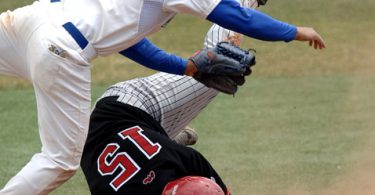If a player is proactive and understands his learning disability, then I think he will thrive in college. He and his parents need to do the research on schools to see what classes sizes they have, and what help they give their student athletes. It is the ones that don’t disclose, or are afraid to talk about, their learning disability that have the trouble.”
Tyler Cook, D1 Assistant Coach
In Part 2 of this mini-series on college baseball academics, we discussed how the NCAA defines Education-Impacting Disabilities (EIDs), the umbrella term that covers student-athletes with learning disabilities. We also described the way players can register their EID with the NCAA Eligibility Center, and outlined the accommodations that being certified makes available. In this article, we continue to provide important insight and information for recruits with EIDs. In particular, we will address how student-athletes can voice concerns about their EID during the recruiting process and make sure each program they are considering has the academic support services that they will need to be successful as a collegiate student-athlete. As we’ve noted before, many recruits and parents are worried that an EID or learning disability will prevent them from playing college baseball. We debunk this myth by answering some of the most common and pressing questions from recruits with EIDs. Keep reading along and you’ll know exactly what you need to do in recruitment to make sure you end up at a school that meets your academic needs!
What additional steps do I need to take during recruitment if I have an EID?
There are several important steps you need to take during recruitment if you are a recruit with a documented EID:
Step 1
The most important step you need to take as a student-athlete with an EID is to recognize that it’s okay! That’s right, you are not the only student-athlete in your situation. More than 10% of college students have a learning disability. It is important that you get comfortable talking about yours. As a student-athlete, it’s up to you to disclose your EID and the only way you can get the help and services that you qualify for is if you come forward and tell coaches about your disability. Coaches can’t help you if they don’t know you have a problem. Be honest and up-front about your EID and get comfortable talking about how it impacts you. That doesn’t mean that you need to disclose your EID in your introductory email, but as your recruitment heats up and you find out more about how the program fits your needs, talking with your prospective coaches will be an important piece of the puzzle. The better you can describe your situation, the more coaches will be able to help you succeed.
Step 2
Once you are comfortable talking about your EID with coaches, the next step is having all your documentation in order. This is one area where getting support services may hit a snag, so get organized now! Your documentation packet of information should include:
- Paperwork with the date you were diagnosed, your diagnosis, and the professional who made the diagnosis.
- A written report from when you were tested and diagnosed. The more comprehensive and detailed this report, the better. It’s likely that this report will be multiple pages with notes and test results.
- Your current 504 Plan or Individual Education Plan (IEP), including the accommodations and support you currently receive (time and half on tests, note taking services, separate classroom for tests, etc.)
- Any prescriptions and medicine that you take as part of your 504 or IEP plan. This is important because if your medicine is on the NCAA’s banned substance list (like ADHD medication), you’ll need to submit a waiver to the NCAA at the beginning of each school year to become exempt.
Having all this information readily available will allow college coaches to help connect you to the school’s Disability Resources Center during recruitment so you can make sure that the school will be able to accommodate you and provide you with the help that you need. If you haven’t already done so, it can be very helpful to make electronic copies of all your documents so you can email them easily.
Step 3
Have the coach and/or academic advisor that works with the baseball team connect you to the disability resources center on campus to make sure:
- Your documentation qualifies you for help at that college or university (every school is different).
- The school has the resources to provide you with the help and accommodations that you need to have success (again, the resources available at each school will be unique).
- You have a clear picture for how you will get the help you need once you are on campus and the steps you will have to take to make that happen.
Will college coaches hold my EID against me?
No. And if they do, that’s not a place you want to play anyways! In fact, showing that you’ve been able to be successful in the face of adversity is a quality that coaches look for and your success should be thought of as a strength. Not only does your success in spite of your disability show that you are resilient, you are also likely to find that helping players with EIDs is nothing new to the coach. He likely has or has had players with EIDs who have been incredibly successful and know how to help or how to get you connected with the people who can help. Think of your coach as a part of the support team.
Who do I need to notify?
As we mentioned in Part 2, if you want to be able to take core courses after graduating and use them for eligibility purposes, you’ll have to get your EID certified with the NCAA Eligibility Center after creating your account. It can’t hurt you to register with the NCAA during recruitment, it can only help. As we mentioned above, you’ll also obviously want to talk about your EID with the coaches at programs you are seriously considering. They are the ones who can begin to answer your questions about accommodations and get you connected with the people on campus that can help you most. In short, it’s your responsibility to disclose and register your EID with the NCAA and on-campus disability services, but the NCAA and the coach recruiting you are a good place to start.
How do I make sure schools will be able to provide me with the support I need?
We’ve saved the most important question for last. If your EID is a major concern for you, then getting the support you need to be successful should also be a major priority in the recruiting process. Every college and university has different academic and disability support services and a different system for getting accommodations and help, so you’ll want to be proactive in the recruiting process to make sure: A) their system has the support you need; and B) your documentation will qualify you for the necessary accommodations and help.
We can’t stress enough how important it is for you to do your homework and have questions ready for the coach, the academic support people, and the disability resources center. You likely already have a good idea of what you need to ask the coach and support staff, but here are some ideas:
- Ask the coach if he’s had players with a similar/the same EID before and how he made sure they got the help they needed. Ask how it went and what kind of help they got.
- Ask the coach to connect you with the academic advisor for the baseball team and the disability resource center directly.
- Ask if the school has a disability resource center or similar office? And if so, if you can be connected directly with someone from that office.
Summary
Every school has a different system for providing accommodations and recognizing EIDs, so you’ll want to be very proactive in the recruiting process getting the information you need. This starts with being honest and open about your EID. Remember, people will be happy to help and it shouldn’t hurt your status as a recruit at all! Next, make sure your documentation is in order. This is the part that slows a lot of student-athletes down once they get to campus, so make it a point to get that information to the academic advisor or disability services during recruitment to make sure you qualify for their system. Things like an old diagnosis date and incomplete or missing documentation can really slow down or prevent you from getting the help you need. Finally and most importantly, cross your T’s and dot your I’s when making sure that the school has the support that you need. There are no silly questions, and you shouldn’t be embarrassed. Most schools have people in place whose entire job is to make sure you get the help you need to be successful!
Here are the links to the first 2 articles of this series:
In our 4th and final article of this mini-series, we’ll discuss in more detail what student-athletes with EIDs should do when they get to campus to make sure they are receiving the support they need and summarize what we’ve discussed throughout the series. Be sure to check back next week for Part 4!







